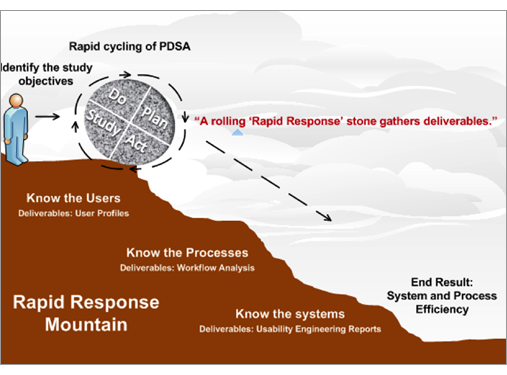Getting started
Plan-Do-Study-Act (PDSA) Cycles
Rapid Response (RR) is a methodology for system and process evaluation and improvement. The methodology utilizes several best practice system and process evaluation and refinement methodologies from different theoretical backgrounds, and structures them to produce maximum results with minimal time and effort. These efficiency gains are produced by the methodology through a rapid Plan-Do-Study-Act (PDSA) cycle (based on the work by Walter Shewhart and Dr. W. Edwards Deming). This PDSA cycle is used to traverse through a study, gaining momentum in the form of deliverables after each iteration of the cycle. This momentum is created when the deliverables from previously completed PDSA cycles are fed back into later PDSA cycles, allowing each new cycle to be completed at an accelerating rate.

Rapid Response Methodology Analogy
An analogy for the Rapid Response methodology can be drawn from a boulder rolling down a steep hill. A boulder that is perched at the top of the hill only needs a sleight push, to ‘get the ball rolling’. Although the boulder initially rolls down the hill at a slow pace, with each passing turn, the force of gravity acts upon the boulder, forcing the mass to accelerate in velocity and gain momentum. As the boulder reaches the bottom of the hill, the rolling boulder attains its highest level of force.
The Rapid Response methodology follows these principles of force and momentum. To start a rapid response study, the study designers must give the Rapid Response boulder an initial ‘push’ by identifying the study objectives. Once such objectives are identified, the RR boulder can start rolling down the hill via continuous PDSA cycles throughout the study design.
The first PDSA cycles of the RR boulder are used to identify the users or participants of the system or process under study. One or multiple rapid cycles of PDSA should be used to identify these study subjects, and create study deliverables in the form of user profiles, which are high level descriptive documents that provide the reader with background information about each unique instance of a user stereotype. These deliverables are then fed back into the RR study PDSA cycles as the RR boulder continues down the hill towards identifying the system processes.
To accurately identify and refine a system process (the second phase of PDSA cycles in RR), one must first identify the process participants. The profile deliverables created from the previous PDSA cycles of the RR boulder can be used for this task; thus, adding to the momentum of the RR boulder by increasing the speed at which process identification and refinement can occur. Successful completion of this phase of the PDSA cycles creates a workflow analysis deliverable, which again, is retained by the RR boulder as it continues down the hill towards the system evaluation and refinement phase.
The final phase of RR (system evaluation and refinement) requires an initial understanding of both user and process factors. Due to this knowledge requirement, the retained deliverables from the previous PDSA cycles of the RR boulder can be applied again, to build the momentum of the study, and conduct the system evaluation and refinement phase quickly and efficiently. The deliverable created in this phase is likely to include some form of usability engineering report, which could then be used to improve the usability (learnability, ease of use, efficiency, safety, effectiveness, etc.) of a system.
After each iteration of the PDSA cycle, the RR boulder becomes more and more powerful, for it builds upon its growing list of deliverables that evaluate and improve the studied system and process, and can be applied to later PDSA cycles. Much like how a rolling boulder reaches its highest level of force at the bottom of a hill, the Rapid Response boulder attains its maximum level of force at the end of a study, for the RR tool carries with it a complete set of system and process evaluation and improvement deliverables.
Unlike a boulder that rolls down a hill, the Rapid Response boulder has the option of rolling back up the hill, to re-perform a previous phase of the study (albeit by losing a bit of the study’s momentum). Such events are not normally necessary; however, may be required if it becomes obvious, later on in the study, that something was missed in the previous phases. Because the RR boulder can retain its previously attained deliverables, repeating phases in a RR study will not greatly affect its overall efficiency.
The remainder of this section will describe these steps of the Rapid Response methodology in detail and provide examples of the best practice methodologies that can be used to achieve process and system efficiency.

News and events
- Publications, presentations, and projects sections of website updated
- Paper published in International Journal of Health Information Management Research (2014)
- Paper published in BMC Medical Informatics and Decision Making (2014)
- Presented at Queen’s Health Policy Change Conference Series (May 15-16, 2014)
- Presented at CAHSPR 2014 Conference (May 12-14, 2014)
- Paper published in Healthcare Quarterly (2014)
- Paper published in Journal of American Medical Informatics Association (2014)